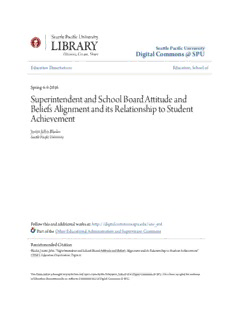
Superintendent and School Board Attitude and Beliefs Alignment and its Relationship to Student ... PDF
Preview Superintendent and School Board Attitude and Beliefs Alignment and its Relationship to Student ...
Seattle Pacific University Digital Commons @ SPU Education Dissertations Education, School of Spring June 9th, 2016 Superintendent and School Board Attitude and Beliefs Alignment and its Relationship to Student Achievement Justin John Blasko Seattle Pacific University Follow this and additional works at:https://digitalcommons.spu.edu/soe_etd Part of theOther Educational Administration and Supervision Commons Recommended Citation Blasko, Justin John, "Superintendent and School Board Attitude and Beliefs Alignment and its Relationship to Student Achievement" (2016).Education Dissertations. 6. https://digitalcommons.spu.edu/soe_etd/6 This Dissertation is brought to you for free and open access by the Education, School of at Digital Commons @ SPU. It has been accepted for inclusion in Education Dissertations by an authorized administrator of Digital Commons @ SPU. 1 Superintendent and School Board Attitude and Beliefs Alignment and its Relationship to Student Achievement by Justin John Blasko Dissertation Presented to the Faculty of the Graduate School of Education at Seattle Pacific University In Partial Fulfillment of the Requirements for the Doctor of Education Degree Seattle Pacific University July 2016 2 3 ii Table of Contents Page LIST OF FIGURES ...................................................................................................... v LIST OF TABLES ...................................................................................................... vi LIST OF APPENDICES .............................................................................................. vii ACKNOWLEDGMENTS ............................................................................................ viii CHAPTER 1: INTRODUCTION TO THE STUDY ................................................... 2 Statement of the Problem .............................................................................................. 4 Purpose of the Study .................................................................................................... 5 Research Question ........................................................................................................ 6 Theoretical Frameworks ............................................................................................... 6 Research Design............................................................................................................ 8 Confidentiality ............................................................................................................. 9 Data Collection Procedures ........................................................................................... 10 Limitations of the Study................................................................................................ 10 Significance of the Study .............................................................................................. 11 CHAPTER 2: REVIEW OF THE LITERATURE……………………………………14 School Boards and Superintendents.............................................................................. 14 School Boards .............................................................................................................. 14 Superintendents ............................................................................................................ 17 Decision-Output Theory .............................................................................................. 19 WSSDA School Board Standards ................................................................................. 22 iii School Boards and Student Achievement ..................................................................... 25 The Lighthouse Inquiry ................................................................................................ 26 Shelton 2010 Study of Kentucky School Systems ........................................................ 32 Lorentzen 2013 Study of Montana School Systems ..................................................... 35 Summary ...................................................................................................................... 37 CHAPTER 3: METHODOLOGY ................................................................................ 39 Research Question ........................................................................................................ 39 Research Design............................................................................................................ 39 Variables ....................................................................................................................... 40 Categorical Variable ..................................................................................................... 40 Continuous Variable ..................................................................................................... 40 Hypotheses ................................................................................................................... 42 Hypothesis.................................................................................................................... 42 Null Hypothesis ........................................................................................................... 42 Population .................................................................................................................... 42 Sample........................................................................................................................... 43 Data Collection ............................................................................................................ 43 Instrumentation ............................................................................................................ 44 Validity of the WSSDA BSAS .................................................................................... 45 Data Analysis ............................................................................................................... 46 CHAPTER 4: RESULTS .............................................................................................. 49 Phase I-Superintendent/School Board Alignment ........................................................ 50 Purposeful Sample ........................................................................................................ 51 iv Instrument .................................................................................................................... 52 Representativeness of the Purposeful Sample ............................................................. 55 Student Achievement Measure ..................................................................................... 57 Phase II- Student Achievement and Superintendent/School Board Alignment............ 59 Statistical Analyses ....................................................................................................... 60 2014 HSPE Writing ...................................................................................................... 61 2014 HSPE Reading ..................................................................................................... 61 2014 Year 1 End of Course Exam ............................................................................... 62 Alignment and Improved Student Achievement .......................................................... 65 Alternative Hypothesis.................................................................................................. 67 Summary ....................................................................................................................... 70 CHAPTER 5: SUMMARY, CONCLUSIONS, AND RECOMMENDATIONS ........ 72 Introduction .................................................................................................................. 72 Summary ....................................................................................................................... 72 Findings and Analysis .................................................................................................. 75 Limitations ................................................................................................................... 80 Practical Implications.................................................................................................... 82 Future Studies ............................................................................................................... 87 Final Thoughts ............................................................................................................. 88 REFERENCES ............................................................................................................. 92 v List of Figures Page Figure 1 Decision-Output Model and School Board Governance ................................ …..7 Figure 2 Student Achievement Linkages in the Decision-Output Theory .................... …21 Figure 3 Academic Achievement Ranking for HSPE Reading .................................... …58 Figure 4 Academic Achievement Ranking for Year 1 EOC Exam .............................. …58 Figure 5 Academic Achievement Ranking for HSPE Writing ..................................... …59 Figure 6 Key Linkages between School Boards and Superintendents and Student Achievement ........................................................................................................... …79 Figure 7 Interaction of Washington State Evaluation Frameworks Supporting Student Achievement ........................................................................................................... …86 vi List of Tables Page Table 1 School Board and Superintendent Team Alignment ....................................................54 Table 2 General Attributes of School Districts Meeting Study Criterion .................................56 Table 3 Standard Error of Measurement Values Used in this Study ........................................57 Table 4 Results of t-test and Descriptive Statitics HSPE Reading, HSPE Writing, and Year 1 EOC Exam .........................................................................................................................64 Table 5 HSPE and EOC Improving and Not Improving Student Achievement Trends ...........65 Table 6 Alternative Hypothesis Results of t-test and Descriptive Statistics for 2014 HSPE Reading Exam ....................................................................................................................68
Description: